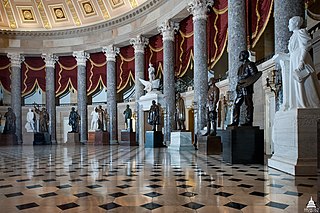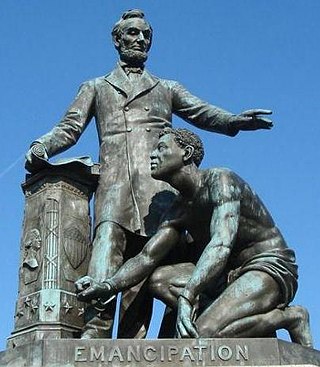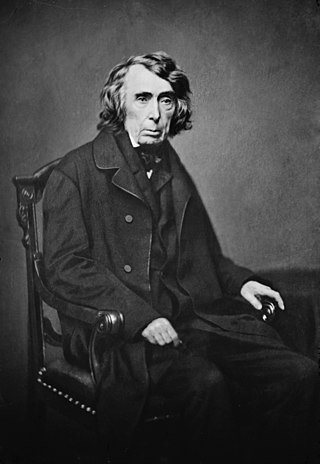Related Research Articles

The National Statuary Hall is a chamber in the United States Capitol devoted to sculptures of prominent Americans. The hall, also known as the Old Hall of the House, is a large, two-story, semicircular room with a second story gallery along the curved perimeter. It is located immediately south of the Rotunda. The meeting place of the U.S. House of Representatives for nearly 50 years (1807–1857), after a few years of disuse it was repurposed as a statuary hall in 1864; this is when the National Statuary Hall Collection was established. By 1933, the collection had outgrown this single room, and a number of statues are placed elsewhere within the Capitol.

The National Statuary Hall Collection in the United States Capitol is composed of statues donated by individual states to honor persons notable in their history. Limited to two statues per state, the collection was originally set up in the old Hall of the House of Representatives, which was then renamed National Statuary Hall. The expanding collection has since been spread throughout the Capitol and its Visitor's Center.

Mary Jane McLeod Bethune was an American educator, philanthropist, humanitarian, womanist, and civil rights activist. Bethune founded the National Council of Negro Women in 1935, established the organization's flagship journal Aframerican Women's Journal, and presided as president or leader for a myriad of African American women's organizations including the National Association for Colored Women and the National Youth Administration's Negro Division.

The South Carolina State House is the building housing the government of the U.S. state of South Carolina, which includes the South Carolina General Assembly and the offices of the Governor and Lieutenant Governor of South Carolina. Located in the capital city of Columbia near the corner of Gervais and Assembly Streets, the building also housed the Supreme Court until 1971.

Richard Lynn Scott is an American attorney, businessman, and politician who has been the junior United States senator from Florida since 2019. A member of the Republican Party, he was the 45th governor of Florida from 2011 to 2019.

The U.S. Commission of Fine Arts (CFA) is an independent agency of the federal government of the United States, and was established in 1910. The CFA has review authority over the "design and aesthetics" of all construction within Washington, D.C. In accordance with the Old Georgetown Act, the CFA appoints the Old Georgetown Board. The Old Georgetown Board has design review authority over all semipublic and private structures within the boundaries of the Georgetown Historic District. The CFA was granted approval authority by the Shipstead-Luce Act over the design and height of public and private buildings which front or abut the grounds of the United States Capitol, the grounds of the White House, Pennsylvania Avenue NW extending from the Capitol to the White House, Lafayette Square, Rock Creek Park, the National Zoological Park, the Rock Creek and Potomac Parkway, Potomac Park, and the National Mall and its constituent parks.

The Emancipation Memorial, also known as the Freedman's Memorial or the Emancipation Group is a monument in Lincoln Park in the Capitol Hill neighborhood of Washington, D.C. It was sometimes referred to as the "Lincoln Memorial" before the more prominent national memorial was dedicated in 1922.

Roger Brooke Taney was an American lawyer and politician who served as the fifth chief justice of the United States, holding that office from 1836 until his death in 1864. Taney infamously delivered the majority opinion in Dred Scott v. Sandford (1857), ruling that African Americans could not be considered U.S. citizens and that Congress could not prohibit slavery in the U.S. territories. Prior to joining the U.S. Supreme Court, Taney served as the U.S. attorney general and U.S. secretary of the treasury under President Andrew Jackson. He was the first Catholic to serve on the Supreme Court.
Confederate monuments and memorials in the United States include public displays and symbols of the Confederate States of America (CSA), Confederate leaders, or Confederate soldiers of the American Civil War. Many monuments and memorials have been or will be removed under great controversy. Part of the commemoration of the American Civil War, these symbols include monuments and statues, flags, holidays and other observances, and the names of schools, roads, parks, bridges, buildings, counties, cities, lakes, dams, military bases, and other public structures. In a December 2018 special report, Smithsonian Magazine stated, "over the past ten years, taxpayers have directed at least $40 million to Confederate monuments—statues, homes, parks, museums, libraries, and cemeteries—and to Confederate heritage organizations."

Mary McLeod Bethune Memorial is a bronze statue honoring educator and activist Mary McLeod Bethune, by Robert Berks.

An Act for the Release of certain Persons held to Service or Labor in the District of Columbia, 37th Cong., Sess. 2, ch. 54, 12 Stat. 376, known colloquially as the District of Columbia Compensated Emancipation Act or simply Compensated Emancipation Act, was a law that ended slavery in the District of Columbia, while providing slave owners who remained loyal to the United States in the then-ongoing Civil War to petition for compensation. Although not written by him, the act was signed by U.S. President Abraham Lincoln on April 16, 1862. April 16 is now celebrated in the city as Emancipation Day.

Carlos Guillermo Smith is an American community activist, lobbyist, and politician. A Democrat, he served as a member of the Florida House of Representatives from District 49, which covered the University of Central Florida area.
The Ten Commandments Monument, authorized by the Oklahoma legislature and approved by the governor in 2009, was installed on the grounds of the Oklahoma State Capitol, in Oklahoma City, in 2012. The mere concept engendered years of political controversy, court suits based on freedom of religion issues, destruction in 2014 by a man who drove his car into it, replacement in the same location, and even attempts to remove Supreme Court justices who ruled in 2014 that the monument must be removed to another site. After Governor Mary Fallin, key legislators, and the justices agreed on a substitute site, the monument was removed from the capitol grounds in 2015.

More than 160 monuments and memorials to the Confederate States of America and associated figures have been removed from public spaces in the United States, all but five since 2015. Some have been removed by state and local governments; others have been torn down by protestors.

Edmund Kirby Smith is a bronze sculpture commemorating the Confederate officer of the same name by C. Adrian Pillars that was installed in the United States Capitol Visitor Center as part of the National Statuary Hall Collection from 1922 to 2021. The statue was gifted by the state of Florida in 1922.

Equal Visibility Everywhere, also known as EVE, is a non-profit 501(c)(3) organization based in Miami, Florida. EVE was founded in 2010 by the psychologist and former college professor Lynette Long, with the mission "to achieve gender parity in the monuments, symbols, and icons, of the United States." Its ongoing projects include adding more statues of women to the National Statuary Hall Collection, creating new historical markers honoring America's heroes, adding images of women to America's paper currency and coins, increasing the number of women honored on stamps and Google Doodles, and increasing the number of female character balloons in parades.
Jerry Sexton is a retired American politician who served as a Republican member of the Tennessee House of Representatives. Sexton represented Tennessee House District 35, an area in East Tennessee consisting of Grainger, Claiborne, and part of Union counties from 2015 until his retirement following redistricting in 2023. Sexton would be succeeded by several representatives, including Rick Eldridge, Gary Hicks, and Dennis Powers, for Grainger, Claiborne, and Union counties respectively following the dissolution of District 35.

There are several works of art in the United States Capitol honoring former leaders of the Confederate States of America and generals in the Confederate States Army, including seven statues in the National Statuary Hall Collection, busts and portraits.